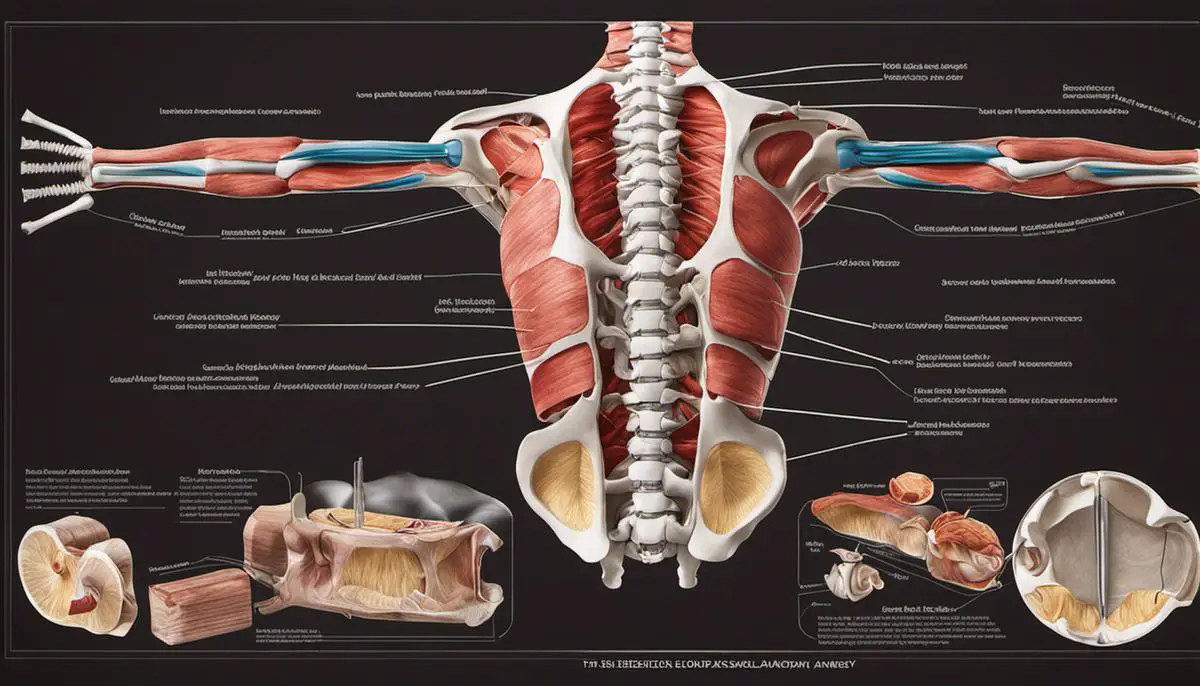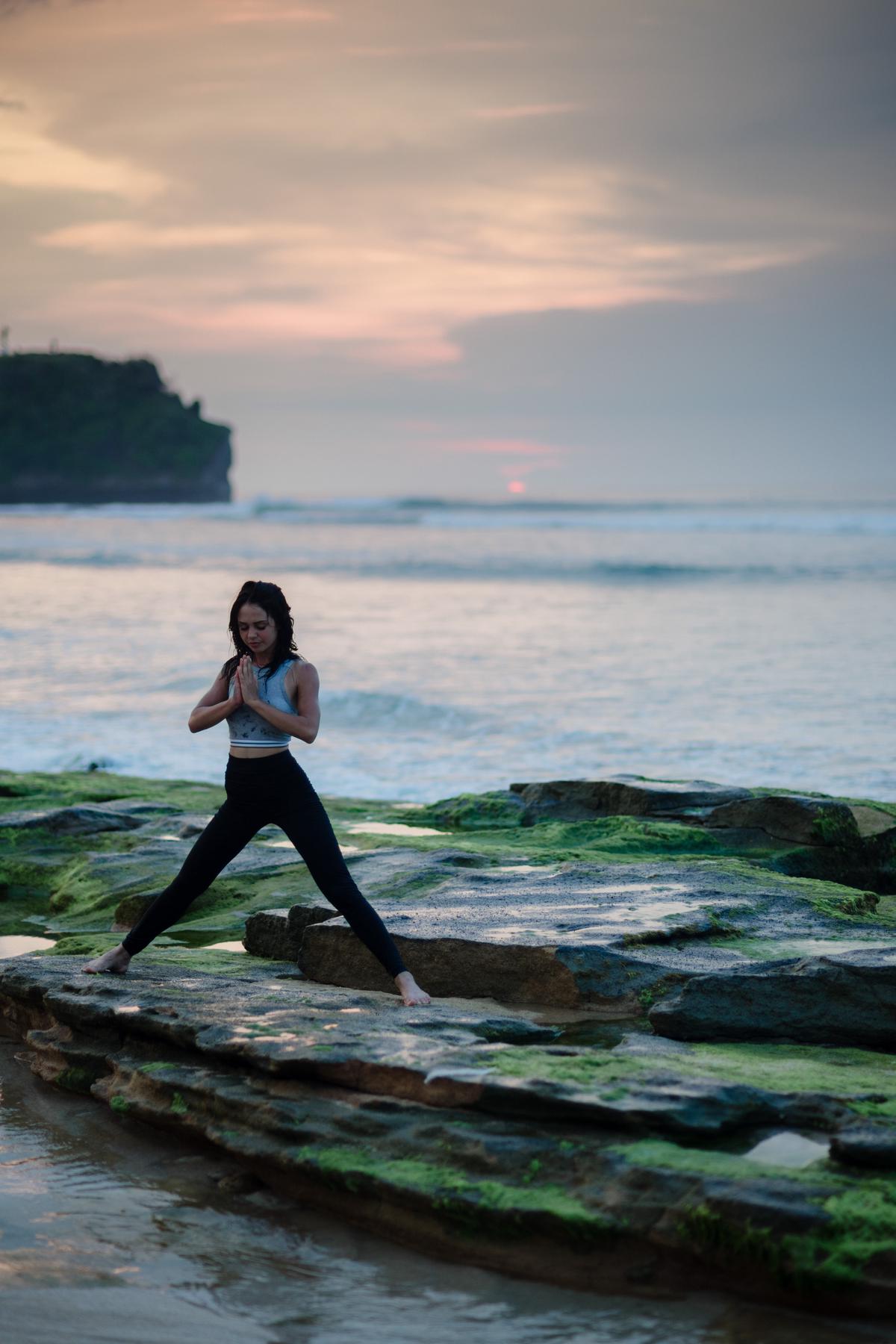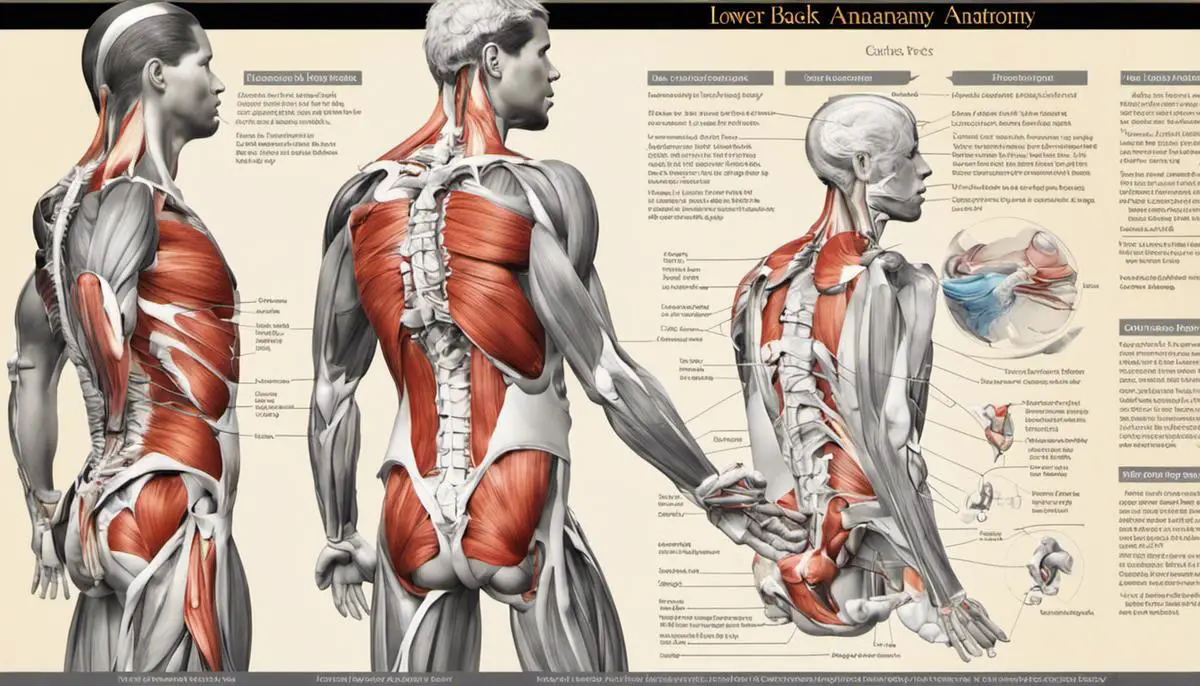The lower back – a complex structure of interconnected and overlapping elements, including muscles, joints, and the spine – is a common area of discomfort and pain for many people. Understanding the underlying anatomy of the lower back is key to addressing this discomfort through tools such as yoga. Yoga, an ancient practice with profound modern applications, offers principles and postures which promote health and wellness, including lower back health. Knowledge of specific yoga asanas (poses) designed to target and alleviate lower back pain is not just beneficial but transformative offering relief and aiding in enhanced physical fitness.
Understanding the Anatomy of the Lower Back
Understanding the Lower Back Anatomy
The biomechanics of the lower back, also known as the lumbar spine, include five cervical vertebrae, the sacrum, and intervertebral discs. The vertebrae are stacked one on top of another, forming the spinal column, which is the body’s main upright support.
Located in between each of these vertebrae are intervertebral discs. These discs, which are made up of a jelly-like substance surrounded by a tough exterior, function as the spine’s shock absorbers and keep the spinal column flexible.
The lumbar spine also houses spinal nerves that are linked to the legs and lower bowel. Hence, injury to this area can lead to leg pain or a loss in bowel control.
Lower Back Muscles
Multiple layers of muscles in the lower back coordinate to support the spine. The largest of these is the erector spinae or the paraspinal muscles which run down from the neck to the lower back on either side of the spine. These muscles work together to keep the spine erect and assist with twisting movements.
A second layer consists of the quadratus lumborum, which is attached to the pelvis and the lower part of the rib cage. It controls the side-to-side bending movements and helps to stabilize the lower back.
Smaller, deeper muscles in the lumbar area team up to make complex movements possible while providing stability. Likewise, the abdominal and gluteal muscles also work with the back muscles to support spinal stability and movement.
Lower Back Joints
Facet joints in the lower back determine the amount and direction of movement between the vertebrae. These small, paired joints on the back of the spinal column function in tandem and offer stability during motion. If these joints become misaligned or imbalanced, pain and limited mobility can occur.
How Yoga Helps the Lower Back
With a proper understanding of lower back anatomy, you can see how yoga could have a profound effect on relieving lower back pain or discomfort. By enhancing muscular strength and flexibility, yoga exercises can encourage better postural habits, which can help alleviate and prevent lower back pain.
Certain yoga poses target certain muscles and aspects of the lower back structure. For example, the downward-facing dog can stretch the erector spinae and enhance spinal flexibility. The cat-cow pose promotes mobility and flexibility of the entire spinal column, including the lower back.
Knowing the function and structure of your lower back will allow you to approach your yoga practice with a new level of intention and focus on your body’s needs. It can also help you modify or correct your poses to target specific issues in the lower back.

Introduction to Yoga
Basic Principles and Concepts of Yoga
Yoga is a comprehensive practice originating from ancient India that combines physical poses, called asanas, with controlled breathing and mental focus. The focus on breath is a fundamental concept in yoga, serving as a powerful tool for mindfulness, stress relief, and energy control.
Breath-work, also known as pranayama, is integral to yoga practice. It involves controlling, extending, and focusing on your breath to help anchor the body in the present moment, increase mindfulness, and initiate a relaxation response in the body.
Asanas: The Physical Poses
In yoga, the physical postures you move into and hold are referred to as asanas. These postures range from simple, such as a seated pose, to more complex, like a headstand. The asanas are designed to help tone, stretch, and strengthen different parts of the body.
For lower back pain in particular, poses like the Child’s Pose, Cat-Cow Pose, Pigeon Pose, and Extended Triangle Pose can be highly beneficial when done correctly. Each of these poses target the lower back and hips, areas often associated with back pain, and help in enhancing flexibility, strength, and posture.
Health and Wellness Through Yoga
Yoga is more than just a physical exercise. It promotes overall health and wellness by integrating physical, mental, and spiritual aspects. Regular yoga practice promotes flexibility, improves muscle tone and strength, and helps in maintaining a balanced metabolism.
The mental benefits of yoga include the enhancement of mental clarity and calmness, increased body awareness, relaxation of the mind, and the sharpening of concentration. Additionally, regular yoga practice can help reduce chronic pain, like lower back pain, by improving posture and alignment.
Breathing exercises and meditation incorporated in yoga also have profound effects on overall wellness. Studies have shown that these aspects of yoga practice can help reduce stress, lower blood pressure, improve heart function, and even boost the immune system.
Different Types of Yoga
There are various types of yoga, each differing in intensity and focus. For example, Hatha Yoga is slow-paced and perfect for beginners, focusing on basic poses and breath control. Vinyasa Yoga is more dynamic, linking breath with fast-paced postures. Iyengar Yoga is ideal for those with injuries or chronic conditions like lower back pain, as it focuses on precise alignment and deep stretching using props like blocks or straps.
Yoga and Lower Back Pain
Careful practice of specific yoga poses can be extremely beneficial for those suffering from lower back pain. With its focus on strength, flexibility, and balance, yoga can help alleviate and prevent lower back pain by strengthening weak muscles and stretching tight ones. However, it’s crucial to practice yoga properly to reap its benefits without risk of injury. Thus, taking professional guidance, especially if you’re dealing with pain or discomfort, is highly recommended.
In conclusion, yoga, with its multifold benefits and holistic approach to health and wellness can be an effective way to manage and alleviate lower back pain, along with fostering overall mental and physical well-being.

Specific Yoga Poses for Lower Back Pain
Child’s Pose
Child’s pose, or Balasana, is a simple stretch that helps elongate the back, making it a good pose for back pain relief. Begin by kneeling on your yoga mat with your toes together and knees hip-width apart. Extend your arms in front of you and lower your hips onto your heels. Extend your torso as you reach your arms forward, keep your forehead resting on the mat. This pose can be held for up to 5 minutes, but stop if you feel any discomfort.
Pigeon Pose
Pigeon pose, or Eka Pada Rajakapotasana, can help release tension in the hips, which could contribute to lower back pain. Start in a downward-facing dog pose, then bring one knee forward and place it behind your same-side wrist. Extend your other leg behind you. Try to keep your hips level as you lower them towards the ground. Bend your torso forward over your front shin and extend your arms on the ground. Hold for 5 to 10 breaths, then switch sides.
Triangle Pose
Triangle pose, or Trikonasana, can strengthen your spine and alleviate backache. Stand tall on your mat with feet hip-width apart. Turn right foot out to 90 degrees and left foot in to 45 degrees. Extend your arms to the sides, then bend at your hip, extending your right hand toward your right foot and reaching your left arm upwards. You should create a straight line running from your left hand through your right and then to your right foot. Rotate your torso to the left, and look upward at your left hand. Hold for 30 seconds, then switch sides.
Spinal Twist
The spinal twist pose can relieve tension and pressure in the lower back. Start by sitting on your mat with legs extended in front of you. Cross your right foot over the left knee and keep it flat on the floor. Wrap your left arm around your right leg and use your right hand as support by keeping it flat on the floor. Take a deep breath and twist your torso to the right, hold for a few, then switch sides.
Cat-Cow Pose
The cat-cow pose helps to lengthen and stretch the spine. Start on your hands and knees keeping your wrists under your shoulders and knees under your hips. As you inhale, arch your spine (cow), and as you exhale, round your spine (cat). Repeat this movement for several breaths.

Developing a Regular Yoga Routine
Deciding on a Routine
Developing a regular yoga routine requires a thoughtful management of your time and an understanding of your physical capabilities. If mornings are the best time for you, schedule your yoga practice right after waking up. Alternatively, if evenings are more conducive to unwinding, then reserve that time for your yoga practice. Maintaining consistency in your schedule is key to seeing improvements in your lower back health and overall physical fitness.
Selecting Suitable Yoga Poses for Lower Back Health
Yoga offers a plethora of poses that can benefit your lower back. Start by integrating poses such as Cat/Cow Pose, Downward Dog, Sphinx Pose, and Child’s Pose into your routine, as these are particularly beneficial for stretching and strengthening the lower back. Be sure to understand the correct way of performing these poses to avoid risk of injury.
Practicing the Yoga Poses for Lower Back
Let’s break down four key poses:
-
Cat/Cow Pose:
Begin on your hands and knees in a neutral tabletop position. As you inhale, drop your belly towards the mat, lift your chin and chest (Cow Pose), and gaze upwards. On the exhale, draw your belly to your spine and round your back towards the ceiling (Cat Pose).
-
Downward Dog:
From a tabletop position, tuck your toes and lift your hips, creating an upside-down “V” shape with your body. Keep your hands firmly grounded as your chest moves toward your thighs.
-
Sphinx Pose:
Lay on your belly with your legs hip-width apart. Prop yourself up on your forearms aligning your elbows directly under your shoulders. Press down into your arms and lift your upper body and head upwards.
-
Child’s Pose:
From all fours, sit back onto your heels, spread your knees apart while keeping your toes together, and lean forward to stretch out across the floor while extending your arms in front of you.
Gradual Progression is Key
As you become more comfortable with these poses, feel free to hold them for longer periods of time or add more complex poses to your routine. Your progression should always be gradual and not forced.
Consistency and Duration
Practicing yoga poses consistently, and for an appropriate duration, is crucial for improving lower back health. Aim for a minimum of 20-30 minutes per session, 3-5 times a week. You may initially feel discomfort or fatigue, but continue practicing consistently, and gradually increase the duration as your body gets accustomed to the regimen.
Monitoring Your Progress
Lasty, keep track of your progress either in a journal or digital format. Note any improvements in your lower back condition, any increase in flexibility or strength, and how you’re feeling overall with your exercise regimen. This can give you valuable insight into your fitness journey and provide motivation to stick with your schedule.

Developing a regular yoga routine that uniquely fits into your schedule and accommodates your lifestyle is foundational in reaping its full benefits, especially concerning lower back health. Through the consistent practice of targeted poses for relief, tranquility, and balance, you can nurture a healthier lower back reducing and preventing pain. It’s essential to remember that each person’s yoga journey is individual, the challenge lies in the exploration to find what works best for you and remaining dedicated. As you continue this journey with yoga, the skills, knowledge, and techniques you acquire offer more than just relief – they serve as a testament to the resilience and adaptability of the human body.
